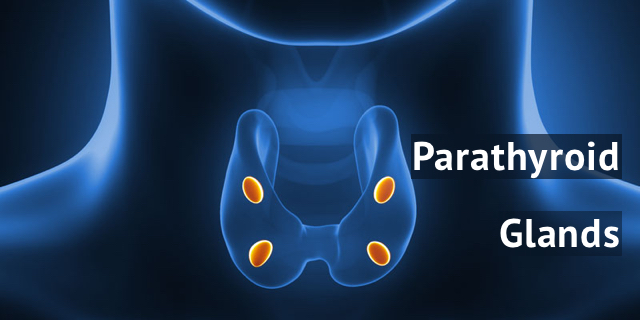Parathyroid glands are located behind the thyroid gland and control the amount of calcium in our blood and bones. About 1 in 100 people (1 in 50 women over 50) develop a parathyroid gland tumor during their lifetime causing parathyroid disease called "hyperparathyroidism". Hyperparathyroidism is a destructive disease that causes high blood calcium--which leads to serious health problems--even early death. It can be cured in most patients in less than 20 minutes by surgically removing the parathyroid tumor. Hyperparathyroidism is not just an abnormal high blood calcium that can be monitored by your doctors. Bad things will always occur and thus the parathyroid tumor should be removed in virtually all cases.

Parathyroid Glands Location
For most people, the parathyroid glands are located behind the thyroid gland (See: What does the thyroid gland do?). But not everyone’s parathyroids are found there. During prenatal development, the parathyroid glands usually migrate from the head to the neck, but in some babies they move farther down and are found in the chest. They can also be found near the jawbone, inside the thyroid gland or even next to the carotid artery.
Parathyroid Glands Function
Although their name has “thyroid” in it, they are separate in their functions from the thyroid gland.
Parathyroid glands perform a balancing act with the electrolytes, calcium and phosphorus (phosphates) keeping tight control of these chemicals in the blood. Calcium is involved in blood parathyroid glandsclotting, normal heart rhythm, muscle contraction, formation of bones and teeth, the actions of enzymes in the gastrointestinal system, transport of nutrients into cells, and energy production. It is also essential for transmitting electrical impulses along nerves. It is an all-purpose electrolyte. Phosphates are involved in energy production in the cell as well as being essential to bone and teeth formation.
When something goes wrong
Primary hyperparathyroidism occurs when one or more of the parathyroid glands enlarge (hyperplasia) or when they have developed a benign (not cancerous) tumor. In extremely rare occasions (1 in 2 million), a parathyroid gland will develop cancer.
Hyperparathyroidism causes the parathyroid glands to overproduce PTH, resulting in high levels of calcium and low levels of phosphates in the blood.
The symptoms of hyperparathyroidism are headaches, fatigue, depression, memory loss and poor concentration. Additional symptoms include kidney stones (due to too much calcium in the blood), osteoporosis (loss of calcium in the bones), hypertension and cardiac arrhythmias.
The longer hyperparathyroidism occurs, the more damage it does to the body. The treatment for hyperthyroidism is surgery to remove the effected parathyroid gland.
Secondary hyperparathyroidism means that something else, besides a tumor, is causing your parathyroids to produce too much PTH. If you have a severe calcium deficiency in your diet, have very low Vitamin D or chronic kidney failure, you can develop secondary hyperparathyroidism.
Hyperparathyroidism risk factors
The average levels of PTH in the body are between 10 and 65 picograms per milliliter (pg/ml). Primary hyperparathyroidism is more likely to occur in older women. It is also more likely in people who have undergone ionizing radiation therapy (not radiation exposures that occur in day-to-day life or from routine X-rays). And people who have been treated with lithium for bipolar disorder are at greater risk for hyperparathyroidism.
-f96812597dd99657cf790d781aed10484e02389417efb7f541bb8c59f60fed17.png)